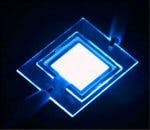"We have made substantial progress in nearly all working areas within the project," comments Peter Visser, project manager of the European integrated project OLLA. “New chemical compounds for OLEDs have been synthesized, characterized and transferred to other partners to be tested in OLED devices.
"Also, optical light out-coupling structures were investigated and our modeling activities helped us to get a much deeper understanding of the basic processes inside OLEDs. These results show our combined progress in view of large area lighting."
ITO-free devices
An indium tin oxide (ITO)-free OLED device has also been demonstrated within OLLA.
As OLEDs gain more and more interest in the field of lighting applications, the consumption of indium is expected to further rise in the future. To replace ITO, a newly developed conductive polymer from H.C. Starck was employed by the OLLA project.
"Until now, our Baytron® material has been used on top of ITO anodes as a Hole Injection Layer (HIL) to improve brightness, lower the driving voltages, and to reduce the defect density of OLEDs," said Andreas Elschner of H.C. Starck. “ We have developed a new formulation of Baytron®, which is especially tailored to reach high conductivity and good optical properties for use in OLED applications."
Baytron® PH500 is a new formulation of the conductive polymer poly(3,4-ethylenedioxythiophene) poly(styrenesulfonate), or PEDOT/PSS in short. It can be applied in solution by common spin-coating, printing or inkjet techniques.
In close cooperation with H.C. Starck, the TU Dresden-based Institut für Angewandte Photophysik (IAPP) has demonstrated a first 1.1 cm2 green OLED using the new Baytron® PH500 formulation instead of a normal ITO anode.
"We measured an efficiency of 18.7 lm/W at 1000 cd/m2 brightness, which is an amazingly high value," said IAPP’s Karsten Walzer. "We could even show that OLEDs on PH500 are more efficient than on ITO. This is due to their better matching optical properties within the OLED." More detailed research results was disclosed during a presentation by IAPP on the SPIE Photonics Europe conference in Strasbourg.
"This encouraging result is one example of many steps we still have to make before commercializing OLEDs in Lighting applications becomes reality," comments Dietrich Bertram of Philips Lighting and technical coordinator of OLLA. "A possible elimination of the ITO layer is a very interesting option in developing this technology towards commercialization."
"However, as the feasibility has only been shown on 1 cm2 so far, additional research has to be done on larger areas."
About the OLLA project
OLLA (Organic LEDs for ICT & next generation Lighting Applications) is a joint research project on the development of white OLEDs for general lighting applications. The goal of the OLLA project is to demonstrate in 2008 high-brightness white OLED light tiles with a long lifetime and high energy efficiency.
The consortium has 24 partners in 8 European countries. OLLA is partially funded under the IST (Information Society Technologies) priority of the European Union’s 6th Framework Programme.







